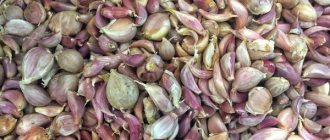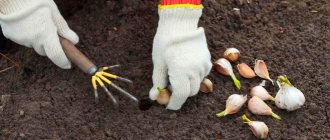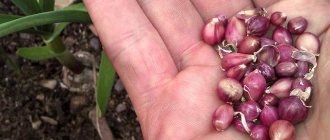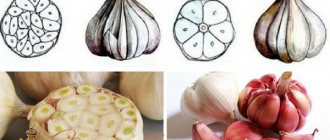Kinds
There are dozens of models of garlic planters on the market, but based on the principle of operation, 3 main types can be distinguished :
- manual garlic cutter;
- seeder on walk-behind tractor;
- seeder for tractor.
Manual
The most economical option . Used in small areas. However, it requires physical effort: you need to set up the seeder yourself, transport it to the site and carry the seeder in front of you, passing through the entire sowing line.
On a walk-behind tractor
Attached to the walk-behind tractor. To operate, it is enough to use special fasteners and adjust the device to the desired mode.
To the tractor
Attaches to the tractor. This seeder is suitable for processing large areas; the design is quite massive. Allows you to plant a large number of seeds.
Types of devices and characteristic features
Modern planters differ in functionality, operating principle and configuration. The choice of model and type of equipment depends on the volume of intended planting and the farmer’s goals.
Manual
The simplest version of a garlic planter. The unit is easy to use, but operating it requires physical effort. The role of the tractor is performed by the farmer himself.
The equipment is adjusted, delivered to the site and adjusted manually. A hand planter can dig furrows using markers.
The main advantage of a manual planter is its low price, durability, and the ability to repair the tool yourself if it breaks.
On a walk-behind tractor
The role of the tractor in this scheme is performed by a walk-behind tractor, which significantly saves manpower. There are practically no disadvantages to such garlic planters; it is enough to refuel the walk-behind tractor on time. Simultaneously with the use of the tool, weeding is carried out. You can dig holes using a coulter.
To the tractor
When sowing garlic on an industrial scale, planters are attached to a tractor. As a rule, cloves are sealed in 5-10 furrows at a time. Similarly, the resulting crop is harvested by attaching garlic diggers to draft equipment.
See also
Description and cultivation of single clove garlic, planting and care rules
Read
Four-row
Four-row garlic planters are most often attached to walk-behind tractors. The soil is prepared in advance and the seed is calibrated. All sections of the mechanism are removable, they can be removed and rearranged.
Landing markers
Using planting markers, future furrows and rows of garlic are marked. The material from which they are made can be different: wood, steel, plastic. The main difference between the devices is the way they mark the landing site with a marker.
Serrated
A popular type of markers used for planting garlic in private gardens. This marker is easy to make with your own hands. Vertical teeth are screwed or welded to a wooden or steel base at equal distances from each other. The handle is being made. This tool is easy to work with; the rows are marked quickly and accurately.
Slatted
The slatted marker visually resembles a rake. The holes are marked by pressing on the base with your foot. To ensure that the furrows are even, auxiliary guide threads are pulled.
Needle-shaped
This type of marker is usually single-row and made of wood. It is a small bar with teeth. The tool is easy to make with your own hands. Often, wine corks are used to create the teeth, securely attached to the main rack.
Different rows of devices
Among other parameters, garlic planters differ in the number of rows they can sow at the same time. Different models can have from one to six rows . At the same time, manual ones almost always have 1 row, because additional rows make the structure heavier and make it less stable, which means it will be more difficult to work with it.
Planters on a walk-behind tractor have from one to four rows, and only models for tractors have 5-6 rows. In addition, some seeders have removable containers, which allows you to adjust the row.
Assemble a garlic planter for a walk-behind tractor yourself
You will have to copy the finished design and simplify it. The principle of the device is simple. The keeled coulter rake the soil and create a furrow. During one revolution of the wheel, several pieces of seeds are alternately fed. The hiller rakes up the soil and fills in the garlic.
The difficulty lies in creating a seeding flow mechanism. The chain version is difficult to manufacture. You will have to purchase separate parts: wheels, shaft, special brushes. The feed of the teeth will have to be adjusted experimentally. Install an impeller in the conical hopper and coordinate the rotation with the movement of the sowing device wheel.
Related video: Garlic cutter
Publications on the topic
Motoblock "Neva" and attachments
Homemade blade from a walk-behind tractor
Operating rules and technical characteristics of the Cascade walk-behind tractor
Pros and cons of different types of device
| Kinds | Manual | On a walk-behind tractor | To the tractor |
| pros |
|
|
|
| Minuses |
|
|
|
Planter for walk-behind tractor
A walk-behind tractor is a necessary farmer’s equipment and draft force for planting garlic . The planters for the walk-behind tractor operate using a chain transmission system: during movement, the device forms furrows into which cloves from the container are poured at a given distance. Then the planter covers them with soil.
Any walk-behind tractor is suitable for working with it; you only need special mounts or adapters. Operating the device is simple; the walk-behind tractor will move the garlic planter independently. Widespread walk-behind tractors: “Luch”, “Oka”, “Bison” and others. Weight – from 17 to 80 kg. Price from 6,000 to 60,000 rubles.
Garlic seeders for mini tractor
Distinctive features are high productivity and high-quality work on any type of soil. Such seeders are suitable for large farms. They can be mounted or trailed, three- or four-row, less often five- or six-row. A garlic cutter in five to six rows will allow you to sow six acres in an hour.
Weight: 47-270 kg. Price: 15,000-200,000 rubles. Manufacturers: P, ATK, "Bobruiskagromash", PE Kryuchkov, AF "Russia", .
Should I buy or make my own?
Assembling a planting device with your own hands is not that difficult , even at home. But this is only advisable in a few cases:
The owner has all the necessary materials. It is important to take the drawing in advance, according to which the planter will be created, and check whether everything is available. Some parts (for example, a chain) can be taken from an old bicycle, others (mounts, containers) can be taken from a garage or workshop. Of course, you can buy a couple of things, but if you purchase all the components separately, it will be easier and cheaper to buy a ready-made device.
- The owner is more or less familiar with agricultural machinery. Otherwise, difficulties may arise, even if you have clear instructions and drawings in front of your eyes.
- You need to make the device “for yourself”. For example, make removable containers for different seeds or install containers for fertilizer and watering. In stores, seeders with advanced functions are always more expensive, and in this case the savings are significant.
If you don’t want to tinker with drawings and the device, collect spare parts, or don’t have enough time for all this, the best choice would be to buy a manual seeder in special stores .
Requirements for sowing garlic
Like any garden crop, garlic or onion cannot be planted in beds without strictly following the recommendations and rules. In order for garlic to grow without problems of shading and mutual inhibition by plants, the garlic seeder must provide several basic conditions during planting:
- When the seeding unit moves along loosened soil, the most even and straight trajectory of movement must be ensured with minimal effort for a person;
- The clove dispenser should dispense seed as evenly as possible and, most importantly, without delays or omissions;
- It is especially important that the garlic cloves are planted in the ground at the same depth.
There are many options for seeders; in most cases, onion and garlic seeders are made by hand for relatively small areas. This can be a manual garlic seeder, or designed as an attachment for a walk-behind tractor. With this device you can sow up to a hectare of land. For large areas, you will need a tractor-mounted garlic seeder with a lot of auxiliary equipment, for example, humidifiers and a tank for adding fertilizer.
Important! Two main performance indicators depend on how accurately the seeder is adjusted - the quality of planting and the force applied to the coulter or planting drum.
When working with a manual seeder, the quality of the placement of garlic cloves is easily verified after the fact, since the gardener always sees and controls the operation of the mechanism. For manual sowing, you need to look for a model that is easy to use. Garlic and onions are always planted in damp, heavily loosened soil, which is difficult to walk on, let alone roll a hand seeder.
You can, of course, convert the device to a walk-behind tractor or tractor. This will make the work easier, but will require extreme attention to the operation of the device and constant adjustments. Otherwise, you can easily plant twenty acres of defective garlic and not even notice it.
How to choose?
There are several main signs by which you can determine whether the technique for planting garlic is suitable in a particular case.
- Principle of operation. The main principle of operation is the same for all seeders: garlic cloves or bulbs are picked up on a chain and planted in a furrow to a certain depth, after which they are covered with earth. The choice of power and row of device depends on the size of the plot and the scale of the farm.
The main types can be divided as follows:- For small gardens with loose soil: a hand planter.
For medium areas: garlic planter on a walk-behind tractor.
- For large farms: tractor seeder.
- Weight .
Manual garlic cutters weigh up to 10 kg. In this case, the principle “the lighter the better” works, since additional weight complicates manual labor. Garlic seeders on a walk-behind tractor weigh from 10 to 70 kg. It all depends on the model and the number of rows. Four-row planters can usually be mounted on both a walk-behind tractor and a tractor. Seeders for tractors are the most massive: from 70 to 100 kg or more. Here the choice of device should be made taking into account the power of the tractor. Models for mini tractors weigh less. - Price.
- Manual: the cheapest of all, but rarely sold in specialty stores. The average price is about 5000 rubles.
- For a walk-behind tractor: much more expensive. Prices vary from 20,000 to 40,000 rubles.
- For a tractor: the most expensive. The cheapest models cost a little more than 30,000 rubles, and the most expensive ones cost more than 100,000 rubles, sometimes the price reaches 200,000 rubles.
Seeding type .
The type of sowing depends not on the type of garlic planter, but on the size of the bowls, planting depth and number of rows. For garlic bulbs, only seeders with small bowls are suitable, as they provide spot seeding - one bulb at a time. Large and medium bowls are suitable for cloves; in such models, several cloves are planted in one place. Suitable sowing depth for seeds: 6-8 cm, and for garlic cloves: 15-20. The sowing speed depends on the row row. Manual planters are almost always single-row, and the number of rows in walk-behind seeders varies from 1 to 4. For garlic bulbs, a four-row planter is suitable. It is considered one of the best, as it ensures more even sowing. And for the largest areas, it is effective to use 6-row planters (usually such models are only available for tractors), which will significantly save sowing time.- Manufacturer . Domestic and Ukrainian manufacturers are leading the market: Poltava, Yarilo, Zvezda, Premium, Bulat, etc. If desired, you can also find foreign brands. Prices rather depend not on the brand, but on the specific models and dimensions of the seeders.
What is a garlic seeder
A garlic cutter is a device that furrows the ground and evenly immerses planting material to the required depth (15-20 cm) in a straight line in one or several rows distributed at a given distance (10-17 cm).
Principle of operation
Planting garlic using a special device occurs as follows: seed is placed in a container, then iron discs evenly distribute the garlic cloves in one layer, the opener makes a furrow to a depth of 15-20 cm, while simultaneously capturing the garlic cloves from the container and evenly plunging them into the ground.
On a note. Sometimes planters are equipped with a container of water to immediately water the plantings.
Models
| Type | Model name | Rowing | Planting depth (cm) | Weight, kg) |
| Manual | SMK-3 VPS27/1-10/4 | 3-row | 1-3 | 3 |
| Garlic planter 1-row Premium | 1-row | 6-8 | 20 | |
| 1-row manual garlic planter with fertilizer hopper Yarilo | 1-row | 6-8 | 15 | |
| Garlic planter 1-row manual Yarilo with support wheel | 1-row | 6-8 | 15 | |
| On a walk-behind tractor | 1-row seeder ChS-1 | 1-row | 6-8 | 20 |
| 2-row model ChS-2 | 2-row | 6-8 | 44 | |
| Attachment for walk-behind tractor | 1-4 rows (removable rows) | 1—10 | 60 | |
| Trailed garlic planter SCH-2 for walk-behind tractor | 2-row | 6-8 | 44 | |
| To the tractor | Four-row ChS-4 | 4-row | 8-10 | 73 |
| Trailed garlic planter SCHT-4 for tractor | 4-row | 6-8 | 98 | |
| 6-row garlic cutter for mini tractor | 6-row | 6-8 | 135 |
At what depth to plant garlic?
In the technology of growing garlic, the depth at which the garlic is planted is also important. It is known that shallow planting of garlic leads to cloves sticking out of the soil with a fast-growing compact bunch of roots, and under unfavorable external conditions, the cloves die. Planting too deeply causes the crop to liquefy, stunting bulb growth and reducing yield.
The depth depends on the time of planting the garlic, the size of the clove and the mechanical composition of the soil. It is calculated from the base of the clove - the bottom, where the growth cone is located and the roots originate, to the soil surface.
- depth of planting garlic before winter (winter) from 7-8 to 10-12 cm
- The depth of planting garlic in spring (spring) is 5-7 cm.
The depth at which garlic is planted is of particular importance for winter garlic; it must be sprinkled so that the layer of soil above the cloves is at least 3-4 cm.
Medium cloves should be planted at 7-8 cm, large cloves should be planted at 8-10 to 12 cm. On light soils, cloves should be planted slightly deeper than on heavy soils. Reducing the temperature in the bottom zone to minus 12-14°C can lead to significant freezing of garlic. A drop in temperature in November without snow is especially dangerous.
To ensure adequate planting depth, especially in large areas, it is necessary to pre-cut planting furrows in accordance with the planting pattern, using a tractor marker or hiller after some conversion, or other mechanisms, for example, a slightly converted old corn planter.
When cutting furrows, pay special attention to their depth, since the depth of planting of garlic will depend on this.
Where can I buy it?
- Garden-shop.
- For walk-behind tractor: 2-row planters (20 -25 thousand rubles).
- For tractor: 4-row (40-50 thousand rubles).
- Delivery within St. Petersburg and Moscow: 1,000 rub. plus 35 rubles/km outside the city (St. Petersburg) and 40 rubles/km outside the city (Moscow).
- Tiu.ru.
Manual: 1-row (10 thousand rubles).
- For walk-behind tractor: 2-row (from 20 thousand rubles), 3-row (from 30 thousand rubles), 4-row (from 40 thousand rubles).
- For tractor: 3-row for mini tractors (from 20 thousand rubles) and 6-row (from 60 thousand rubles).
- There are universal planters - from 100 to 200 thousand rubles.
- Pickup in St. Petersburg and Moscow.
- Delivery cost 500 rub.
- Agrotrade.
- For tractor: 3-row (100 thousand rubles) and 4-row (200 thousand rubles).
- The timing, cost and method of delivery by region depend on the weight of the cargo, dimensions and final destination and in each case are agreed with the store manager.
- Equipment store 100kwatt.ru.
- For walk-behind tractor: 2-row and 4-row (from 20 thousand rubles).
- For tractor: 4-row (from 40 thousand rubles).
- Delivery costs are calculated individually.
Advantages
The presence of the described device in the household is determined by its convenience and at the same time aesthetics. Once you try to plant garlic under a marker, you will not be able to refuse to use such a device in the future. With its help, it is easy to quickly mark the beds.
Thanks to the special design, gardeners are able to place planting material at the optimal depth, allowing the garlic to withstand winter frosts, spring floods, and summer heat.
How to make a seeder?
Materials:
- a transparent plastic jar (will be a container for seeds);
- bolt;
- plastic tube (you will need to cut a piece that fits the depth of the jar);
- a metal tube slightly narrower in diameter;
- 2 washers for fixing the can;
- screw;
- a tin can (you can just use a lid);
- aluminum wire;
- wooden handle;
- hoe.
Inventory:
- drill;
- knife;
- scissors;
- nail;
- lighter;
- matches.
Drawing:
Instructions:
The plastic jar needs to be drilled through. The hole must be located exactly in the center - this is important for the stability of the structure.
- Remove the cover. Make a triangle-shaped hole on the side (for seeds).
- Cut the lid from a tin can. This will be the valve that regulates the filling of seeds. The valve must be attached to the jar with wire so that it can open and close freely.
- Cut a piece of plastic pipe and insert it into the center of the jar. This way the can will not shrink as the bolt is tightened.
- You need to insert a metal tube into a piece of plastic pipe - this will create a bearing. As a result, the can should rotate - this is a sign that the design is working correctly.
- A bolt is in turn inserted into the metal pipe. You need to tighten it with a nut between two washers - this will make rotation free.
- Make 2 holes on the side of the plastic jar with a hot nail. In this case, the diameter of the nail will be the same as that of the garlic clove that will be planted.
- Drill a hole in a wooden handle for a bolt and screw it to the tank (can).
- Bend the hoe and attach it with wire to the handle, above the tank.
Possible problems and warnings
When manufacturing each of the seeders, it is imperative to follow safety precautions. It is necessary to use personal protective equipment: protective gloves, boots, etc.
A planter for a walk-behind tractor is difficult to assemble without welding skills. In this case, it is better to buy it in a store. A walk-behind seeder weighs quite a lot, and during operation, seed and people make it even heavier.
For small private farms, homemade models are the most suitable.
Tags: marker, planting, size, hand, yours, garlic
About the author: admin4ik
« Previous entry
DIY walk-behind tractor
Materials:
- channel "eight";
- wheels;
- steel sheets;
- bolts;
- nuts;
- locknuts;
- plywood sheet;
- drying oil;
- rubber lining;
- metal pipes;
- thorns;
- pins;
- metal hub and bearings (if you make the wheels yourself);
- chain (or belt);
- wooden boards;
- pedals.
Equipment: welding machine.
Drawing:
Assemble the frame. From metal “eight” channels you need to weld 2 parallel spars and 3 cross members. The size is calculated in advance.
- In front of the side members, weld an arch with a fastening fork and 2 fastenings (for the lower link) on the sides.
- Secure the supports for the seed tubes to the sides of the frame.
- To strengthen the frame, braces need to be welded from the central cross member to the arch. Strengthen the arch with two rectangular plates and steel corners (5 mm piece of steel). You should end up with a right triangle.
- Make a bunker. To do this, cut a sheet of plywood according to the dimensions of the frame and assemble it with metal corners. The finished product is covered with drying oil and left for a while to dry. It is worth putting a rubber lining inside the hopper so as not to damage the garlic cloves or seeds.
- The hopper must be installed on the frame from above.
The structure is secured with four bolts and locknuts, after which the conveyor is installed. The conveyor can not be welded, but secured with bolts. - Screw the hopper firmly to the frame (it must support a weight of up to 25 kg).
- Secure the ripper holders to the structure (screw them with bolts).
- Make a wheel axle. To do this, weld the axle pipe to the frame and drill holes in it for the pins holding the spikes. After complete assembly, be sure to weld the pins.
- You can also assemble the wheels yourself. To do this, put two bearings on metal hubs and attach them to the axle.
- Make a holder for rippers. Weld the metal corners in the form of a square, then weld them to the rod, onto the ends of which steel pipes are also welded (within them there are cultivating paw stands).
- Weld a groove cutter made of a sheet of steel to the pipe. To control the depth of the furrow, you will need to raise and lower the seed tube.
- To drive, the planter wheel is connected to the walk-behind tractor wheel using a chain or belt.
- Prepare the seat and legroom. For seating, metal crossbars are welded to the frame, on which boards are fixed. For convenience, the seat can be upholstered with fabric. For the legs you need to attach the pedals to the overall structure.
Slat markers
If you need to make shallow grooves in a small area, in a greenhouse or greenhouse, then a slatted marker will come to the rescue.
Triangular slats are nailed to the board from below, and a handle is attached to the top. To make transverse rows, the device is placed on the ground and pressed from above with your foot. For longitudinal beds, use a marker with teeth, reminiscent of a rake. Only instead of ordinary teeth, the tool uses short triangular bars.
And the most simplified option for small beds is a small marker with triangular strips.
Tools and materials
To make a potato planter with your own hands, you will need a considerable set of tools and parts. Let's consider this completeness.
- Axles, a chain from a bicycle (or a chain from a car engine), bearings for wheels and creating a chain lift.
- Iron sheet for the construction of a loading tank.
- Iron profile with a round or square cross-section - for mounting a holding frame and other purposes.
- Welding equipment for reliable connection of potato planter components to each other.
- Electrodes of various powers for welding work.
- Angle grinder and wheels for cutting iron sheet into suitable parts.
- Electric drill and drill bits for it for drilling work.
- Fastening parts for device reliability.
- Nuts and bolts for mounting the structure.
- Several meters of wire to secure individual parts of the device.
- Sandpaper or file for grinding and cleaning elements.
You must first make all the drawings (can be found in specialized literature or the Internet), carefully study them, think over the dimensions of the future device and its appearance, and the method of fixing it to the motorcycle. The dimensions of the potato planter should not be very large in order for the device to be in accordance with the available motor equipment.
The capacity of the container for filling tubers is determined based on the calculation of the double length of the bed. The volume of the bunker should be enough for the walk-behind tractor to pass two furrows with the container filled and return to the secondary loading station.
Planting garlic - the best calendar dates and rules
The more epidemics of all kinds there are, the more often deadly viruses mutate, the more expensive medicines in pharmacies (not always effective), the more important the role of a wonderful natural healer.
Garlic will never let you down. I'm a long-time subscriber. I like that the conversation takes place online: as soon as you have time to read something, the next few pages contain additional recommendations with approval or criticism of what was stated.
I have been observing the cultivation and storage of garlic for a long time. Many readers, due to poor storage of winter garlic, prefer spring garlic. Many storage methods were proposed: in ash, in salt, in oil, in paraffin, etc. Some advise storing it in the refrigerator, and until January at the latest. I keep garlic all year round!
Until the new harvest ripens, we use garlic in various marinades and pickles. Three years ago, already in the fall, it was a pity to throw away the old garlic in September, I planted it between the currant bushes in a separate bed - on the first greenery in the spring. The garlic grew beautifully and differed little from the new one; the heads were no smaller.
The success of storage depends on many factors, including agricultural cultivation technology.
N.V. Dorofeeva spoke in detail about the preparation of beds, planting and care, and I want to correct her in some ways and add my thoughts.
Link on topic: Garlic before winter - autumn planting
Garden bed for planting garlic
I prepare a bed for garlic ahead of time, level it and sprinkle a 3-5 cm layer of compost on top with the addition of chalk and ash, since garlic loves alkaline soil.
About ten years ago I came to visit a friend at his dacha, and, as always, I walked around the garden, oohing, ahhing. In the area with strawberries, powerful bushes caught my eye.
When I asked what it was, the owner took a shovel and pulled out of the ground... a garlic bush.
This was not a sight for the faint of heart! If they told me, but I didn’t see it myself, I would never believe it! Imagine: 5-6 large heads of garlic with a powerful root system.
My friend’s agricultural technology is simple: in the fall, he plants a clove of garlic in the free spaces between the strawberry bushes and forgets about it for two years.
So think about when is the best time to plant it. For myself, I decided: I plant garlic after August 25, taking into account the lunar calendar
. In autumn in Siberia, the planting day does not always coincide with good weather, especially if you rely on the lunar calendar, so sometimes you have to shift the dates.
Device for planting garlic
For convenience and speed up landing, I use a simple “device” (photo 1). It is a board 70x7x2 cm, to which wedges from the same board are nailed 4 cm wide, decreasing to 3 cm.
All wedges are the same length - 15 cm, although it is better to increase the outer ones by 1 cm - this makes it easier to mark the beds. The distance between the axes of the wedges is 15 cm.
For those who find it difficult to work while bending down, you can nail a handle to the center of the bar on the stable side of the wedges and work while standing.
I selected all the dimensions based on the size of my bed, the width of which is 70 cm. I recommend making the distance between the holes 7-8 cm, for me they turn out to be 15 cm, but I plant 2-3 cloves in the holes, and they get along perfectly.
For the sake of experiment, I plant 1 clove for several rows, but the largest ones. In general, the harvest is about 2-3 cloves less, but the heads are larger, which I then use for planting.
I choose the length of the wedges a little longer than recommended, especially if I plant “three-finger combinations.” At the bottom of the garlic cloves there are tubercles - future roots. They are very delicate, and when planted by pressing into the ground, some of them are destroyed. Even if this garlic grows, it will still be unripe and weakened, so it is poorly stored.
Now how do I plant. A day or two in advance, I water the garden bed abundantly: when planting, the soil should not be sticky, but should not crumble. I make the holes as follows. First, along the edge of the bed, I pull the cord and, touching it with the edge of the “device,” I draw 5 strips along the bed (if the outer teeth are enlarged, you get 2 stripes).
From the edge of the bed, perpendicular to the stripes, I make 5 holes. I press the “adjustment” to its full depth, then take it out, wiggle it slightly so that it crumbles less.
No matter how hard I try, some of the earth falls into the hole, but there’s nothing to worry about: after all, it’s mostly the compost with fertilizer that crumbles, and we have a reserve for the depth of the hole - the soil at the bottom becomes looser and will injure the bottom of the clove less.
I make the rest of the holes like this: first along the edges along the bed, and then along the width. The first 25 holes are done and everything is repeated. If you go through the finished holes again, but reduce the direction of the “fixture”, the holes will become almost round.
Related link: Rocambole – onion or garlic or onion garlic?
Preparing garlic seeds for planting
Now about the seeds. For planting, I select large heads of garlic, on the day of planting, I separate them into cloves and soak them. Previously, I soaked it in copper sulfate (1 tbsp per 5 liters of water), and last year I tried soaking it in the solution suggested by reader N.V. Dorofeeva from Voronezh.
After soaking, the garlic needs to be planted as soon as possible, because the roots quickly hatch in the bottom. I plant 2-3 cloves in each hole at the required depth (and this depth varies in different regions - from 5 to 15 cm). At the same time, compost with fertilizers covers the cloves.
I do all this with a wooden mop. You have all probably seen how workers level the asphalt - they get a very smooth surface.
I found such a mop at a garbage dump, it was too big and the owner apparently didn’t like it, but I appreciated it and level the beds only with it: using it to compact the soil after planting is a pleasure.
Caring for garlic comes down to loosening and watering.
To cultivate the beds, I use my rippers (photo 2, 3). Many people use flat cutters, hoes, and rakes, but in fact, wire rippers are the best: they do not have sharp or cutting edges, therefore, when processing the surface, they do not cut weeds, but pull them out. After all, when weeds sprout, they look like thin threads.
I make rippers from stainless steel wire with a diameter of 1.5-3 mm. To make the first tools, I used wire from a spring expander. I make rectangular rippers with a handle 1.2 - 1.5 cm long - they are very convenient, while standing, to walk along the beds and loosen them. I do this with pleasure.
Diamond rippers are convenient to use when removing weeds near vegetables, thinning plantings of carrots, beets... Throw a loop on it, pull it, and you're done. Weeding or thinning out weeds with your fingers is much more difficult and takes longer, and often instead of a weed you pull out something you don’t want...
Making such shelves is very simple; for this you need a small vise and a steel tube: with its help it is convenient to bend the wire in the right place. There are many ways to attach shelves to handles.
The simplest is to drill a hole in the end of the handle according to the thickness of the wire and fill it with epoxy. A good way is to attach it with clamps, which are sold in a wide variety in auto and plumbing stores.
In this case, the ends of the wire need to be bent, and the structure will become stiffer.
Storing garlic - right and wrong
And now about storing garlic. It all starts with cleaning. Garlic is very afraid of mechanical damage.
All you have to do is press the head harder, or it will fall off the table onto the floor, such garlic will no longer be stored.
I pull out the heads with the help of a spatula: a spatula in my right hand, a bush in my left, and I slowly push them out. I remove the earth only with my hand, do not hit the heads against each other under any circumstances!
Then the garlic is sent for drying. I don’t leave it in the beds: dew and rain do not allow the garlic to dry out, and it can rot.
Even as a child, my grandmother made me install garlic vertically in the shed. The walls there were made of wicker, the room was dry and drafty - an ideal place for drying.
I send the dug garlic to the veranda and lay it vertically along the walls in a thin layer for 10-15 days. During this time, the stems dry out and all the beneficial substances pass into the head.
I cut off the roots with scissors, leaving 5-10 mm, and with my thumbnail I remove the upper part of the peel shell, while the top of the teeth is exposed and the interdental sinuses open (photo 4).
Related link: Giant garlic - the secret of growing
This is very important: in garlic that has not been processed in this way, conditions for rotting are created inside the sinuses, but in processed garlic, even if one clove rots or dries out, the rest will remain intact.
Next - drying again. I spread newspapers in the corner of the room and scatter garlic in a thin layer.
After a month, I sort it, and put the one that is intended for storage into a canvas bag, then into a plastic bag, in which holes with a diameter of 10-15 mm are made.
(I tried burning the tails, but got nothing but extra dirt.) I store this bag in the dark on the floor, and my friend stores it in the closet on a shelf, and the results are excellent.
Try it and you will succeed!
© Yu.V. KOPYLOV, Tomsk
Below are other entries on the topic “Do-it-yourself cottage and garden”
- Planting garlic is a great way to yield: Harvesting garlic = planting This is not...
- How to store garlic: GARLIC IS STORED ALL WINTER I want to tell you...
- Spring or winter garlic - differences?: Winter and spring garlic: how...
- Garlic in the Moscow region - planting and storage: Growing garlic in the Moscow region...
- Growing garlic in the Moscow region - tips for planting and care: Garlic in the Moscow region - planting,…
- Proper cultivation of garlic on the plot: Some tips for growing garlic...
- Why does garlic degenerate and become smaller?: To prevent garlic from turning yellow, do not...
Source: https://vsaduidoma.com/2016/10/20/posadka-chesnoka-luchshie-kalendarnye-sroki-i-pravila/
Planter with beveled edge and long handle
This type of planter was created specifically for digging holes for small bulbs without bending over. It differs from a conventional planter with two handles in the shape of the planting cone (a cylinder beveled at the top) and the presence of only one leg support.
Advantages : comfortable position for work, relatively light weight, it is possible to work with small bulbs.
Disadvantages : not suitable for creating holes for medium and small bulbs.
Planter manufacturing process
A homemade planter is basically a cart on wheels connected to motorized equipment. It is only at first glance that the design of the unit for planting potatoes looks simple, but there are certain nuances in it. The planter for walk-behind tractors is mounted on a frame made of sections of 8-mm channel with two enfilading spars coupled with three cross members. In the front area of the chassis there is an arch with a fork attached to the central link. At the edges of the frame there are racks of closing discs and plate supports for the seed feeder.
The wheelbase includes 2 lug wheels. Between the wheels there is a disk made of wood 60 millimeters thick with 4 proportionally placed semicircular passages, the dimensions of which should make it possible to capture even large tubers. In addition, instead of wheels with grooves, a structure made of gears, a chain and tuber grooves placed on it can be used for planting potatoes.
There is another significant component of the design - this is a bunker, which is located above the wheels. To create a loading hopper you will need a 3mm sheet of iron. The narrow neck and bottom of the container must be covered with rubber to prevent damage to root crops.
The wheel with grooves must be covered with a specialized shield, which will prevent the potatoes from falling out on their own until the required moment of their entry into the ground.
Bulb planter with spring handle
gardenorchid.co.uk
Externally, this planter is very similar to its predecessor: the same shape, the same principle of working with the soil. However, if you look closely, you will notice that its landing cone consists of two parts, and there is a button on the handle. It is she who sets in motion the mechanism that opens the cone to a cylinder. The principle of working with the planter has changed slightly, but it seems so only at first glance. The spring mechanism greatly facilitated the landing process. Now, in order to get a lump of earth, you do not need to rotate the cone around its axis.
A planter with a spring handle is an ideal option for those who plant tulips, hyacinths, hazel grouse, daffodils and other plants with large bulbs on their plot.
Advantages : no need to make unnecessary hand movements, it’s easy to fill the bulbs.
Disadvantages : uncomfortable body position during work, not suitable for planting small diameter bulbs.











